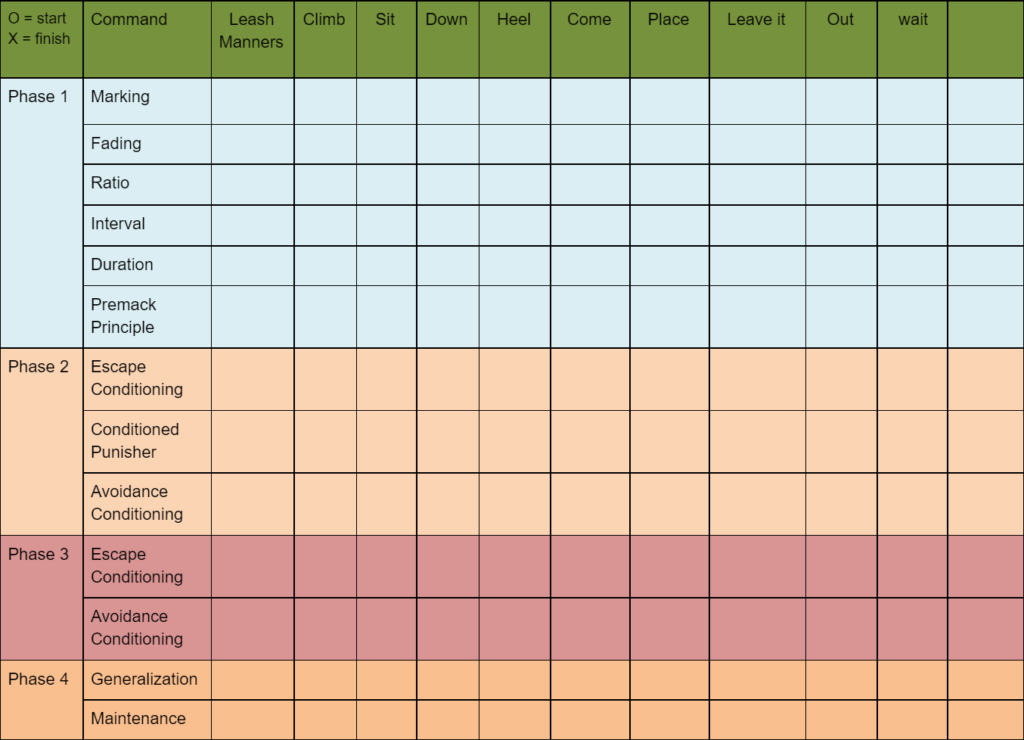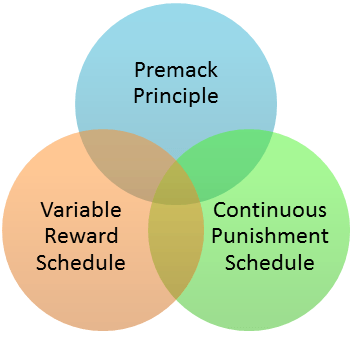- Objectives
- Review, what is a command structure?
- Why do we learn the first half first?
- Two components to focus on early are
- Name
- and just one single concept of encouraging behavior: the Ratio Schedule
- What is a marker and considerations and choosing which one to use
- Serious thinsg to be aware of in regards to differences between training for competitive obedience and "real life" obedience.
This is a concept that is ideally addressed early. Clients should be taught how to choose and maximize the use of the proper reward ratio because this concept will then be applied to more complex exercises that relate to their dog's obeying for longer periods of time and around heavier distractions.
Ratio - How many repetitions of the behavior before reinforcement

Learn about the name here: The importance of the name

The best way to be skilled at using positive punishment and negative reinforcement in dog training is to be excellent in understanding how to maximize what can be accomplished with positive reinforcement and negative punishment and how you can apply it to daily activities through Premack's Principle.
Continuous CRF
Partial PRF (intermittent)
Fixed FR- predictable
Variable VR- unpredictable (to the dog)
Understanding classical conditioning terminology is important for high-level dog training professionals that will be teaching and referencing other trainers that are using common terminology, but the CONCEPTS are easy to understand and have been in use way before anyone put labels to them.
Especially when working with clients, favor the understanding of the concept over semantics.
"Marker" is a common term that can be a synonym, depending on the context with, with the broad classical (Pavlovian) conditioning term "conditioned stimulus" or the more specific types: conditioned reinforcers/punishers.
The terms secondary reinforcers and secondary punishers are also in common use and give more information about what type of marker is being used. These common terms are likely evolved from the pre-Pavlov 1911 publication, Training Dogs: A Manual, by Konrad Most who described the use of primary and secondary inducements.
I recommend using natural conversation markers like "good girl!" for most pet and working dogs, but it depends on preference and specific situations.
Suggested Reward Ratio for Most Pet and Working Dog Obedience
continuous-ratio marker (1:1) and continuous-ratio reward schedule (1:1)
This can also be labeled CRF
Best for learning the connection to the behavior and the marker and the marker to the reward.
| Behavior | 1 | 2 | 3 | 4 | 5 | 6 |
| Marker | M | M | M | M | M | M |
| Reward | R | R | R | R | R | R |

Continuous-ratio marker (1:1) and fixed-ratio reward (2:1) schedule
It is recommended for most pet and working dog applications that the dog is told (with the marker) that they are correct every time, even though they may not get a reward every time.
This can also be labeled FR2 schedule meaning that reinforcement will occur every second time the behavior occurs.
| Behavior | 1 | 2 | 3 | 4 | 5 | 6 |
| Marker | M | M | M | M | M | M |
| Reward | R | R | R |
Continuous-ratio marker (1:1) and fixed-ratio reward (3:1) schedule or FR3
| Behavior | 1 | 2 | 3 | 4 | 5 | 6 |
| Marker | M | M | M | M | M | M |
| Reward | R | R |
Continuous-ratio marker (1:1) and variable-ratio reward (6:4) or (3:2) schedule
This is considered a dense schedule because the behavior is reinforced more than it is not.
| Behavior | 1 | 2 | 3 | 4 | 5 | 6 |
| Marker | M | M | M | M | M | M |
| Reward | R | R | R | R |

Continuous-ratio marker (1:1) and variable-ratio reward (2:1) schedule
This is an even schedule. The dog, on average, is rewarded for behavior about the same that is not rewarded for the behavior.
| Behavior | 1 | 2 | 3 | 4 | 5 | 6 |
| Marker | M | M | M | M | M | M |
| Reward | R | R | R |

Continuous-ratio marker (1:1) and variable-ratio reward (2:1) schedule.
This is a thin schedule.
| Behavior | 1 | 2 | 3 | 4 | 5 | 6 |
| Marker | M | M | M | M | M | M |
| Reward | R | R |


Alternative Considerations
Competitive obedience
| Behavior | 1 | 2 | 3 | 4 | 5 | 6 |
| Marker | M | M | M | |||
| Reward | R | R | R |
| Behavior | 1 | 2 | 3 | 4 | 5 | 6 |
| Marker | ||||||
| Reward | R |
AKC Obedience

Protection Sports Style Obedience

Low-frequency behaviors that need high reliability
Bob Bailey, etc..
| Behavior | 1 | 2 | 3 | 4 | 5 | 6 |
| Marker | M | M | M | M | M | M |
| Reward | R | R | R | R | R | R |





Responses